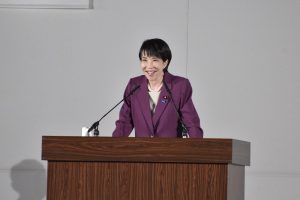A protégé of Abe Shinzo, newly elected Liberal Democratic Party President Takaichi Sanae inherits her mentor’s approach to social, economic, and foreign policy. Given U.S. President Donald Trump’s admiration for strong conservative leaders and his close affinity with Abe, Takaichi – Abe’s hand-picked successor – is ideally positioned to strengthen the Japan-U.S. alliance. With Trump’s impending visit to Japan scheduled for October 27, the two leaders have a unique opportunity to build rapport and a more robust Indo-Pacific security architecture.
Aligned politically and ideologically with Trump, Takaichi champions tax cuts, stricter immigration controls, restrictions on foreign land ownership, and severe penalties for flag desecration – populist policies that closely mirror Trump’s. She has also openly criticized her own country’s central bank policies, pledging – in Trumpian terms – to “make Japan once again a vigorous land of the rising sun.” Their shared penchant for provocative, nationalist rhetoric and populist politics provide a foundation for a potentially productive working relationship.
Yet, Takaichi’s greatest obstacle remains securing the premiership. Despite winning the leadership race, the once-influential former Abe faction has weakened significantly, losing 40 percent of its members in just a year, forcing Takaichi to rely heavily on veteran politician and former Prime Minister Aso Taro. Her Cabinet selections reflect this dependence, with little room for past rivals.
Domestically, Takaichi faces increasingly challenging coalition dynamics after Komeito’s withdrawal from the ruling coalition, ending a 26-year partnership. This development will complicate her ability to govern effectively. Meanwhile, she must continue to defend her conservative credentials against pressure from the rising far-right Sanseito. Assuming she is able to secure the premiership in the upcoming Diet vote, urgent economic issues – particularly inflation and rising living costs – may initially constrain her ability to focus on foreign policy.
Nevertheless, while she’ll face a tighter timeline to prepare – far shorter than the 30 hours of extensive briefings afforded to outgoing Prime Minister Ishiba Shigeru – Trump’s upcoming visit offers Takaichi a strategic opening. To maximize the meeting’s potential and maintain the alliance, there are three key areas which Takaichi is likely to address.
First, she will probably discuss defense spending. Japan’s defense spending has surged 61 percent since fiscal year 2022. Combined with Takaichi’s longstanding advocacy for higher defense spending, this helps counter perceptions of an imbalance in the Japan-U.S. alliance. To clearly signal Japan’s commitment to taking greater responsibility for its own security, Takaichi could present Trump with explicit spending targets beyond the current goal of 2 percent of GDP by 2027. Committing to concrete spending increases would strongly resonate in Washington and reassure political appointees at the Pentagon. Additionally, Takaichi’s continued support for revising Article 9 of the Japanese Constitution would further demonstrate Japan’s seriousness about meeting its defense obligations.
Second, Takaichi may discuss strengthening security frameworks. On a bilateral level, Takaichi’s consistent support for counterstrike capabilities and hosting U.S. long-range missiles in Japan aligns closely with recent advancements in Japan-U.S. defense posture. Deployments of sophisticated missile systems such as NMESIS, MADIS, and HIMARS, submarine-launched and land-to-ship long-range cruise missiles, the retrofitting of the JS Chokai to carry Tomahawks, and the establishment of the Japanese Self-Defense Forces Joint Operations Command, all fit seamlessly into Takaichi’s strategic vision. Additionally, her proposed “spy prevention law” to safeguard classified information and dedicated national intelligence bureau could enhance Japan’s integration into U.S.-led intelligence sharing frameworks, moving Japan closer to Five Eyes standards.
Takaichi could also propose deepened multilateral security cooperation, particularly on the Quad and the Squad. In 2007, Abe pulled together the Quad – Australia, India, Japan, and the United States. In 2017, Abe and Trump revitalized it. Now, Takaichi could work to further cement their legacy by emphasizing the importance of Trump’s personal participation in high-level multilateral fora. Despite recent India-U.S. tensions delaying a Quad summit, Takaichi may nevertheless advocate for a prompt leader-level meeting to maintain momentum once India and the United States reach a trade deal. And given the administration’s focus on hard security, scheduling a Squad defense ministers meeting – or even encouraging a leader-level Squad summit – would affirm Japan’s, and Takaichi’s, strategic leadership while visibly demonstrating sustained U.S. commitment to Indo-Pacific security.
Regionally, Takaichi’s assertive approach toward China – exemplified by her April visit to Taipei and proposal for a democratic “quasi-security alliance” – positions her as a powerful advocate for enhanced Indo-Pacific cooperation. Japan’s moves to normalize joint maritime drills with Taiwan and the recent reciprocal access agreement with the Philippines presents an ideal moment to formalize these bilateral agreements into a broader Pacific Defense Pact or “INDOPACT.” It’s in Washington’s interest to actively pursue such an initiative with Japan, Australia, and the Philippines – and consider involving Singapore, the United Kingdom, South Korea, and Taiwan as observers to coordinate on strategic planning.
Third, the matter of historical tensions with South Korea could be raised. Unlike Ishiba’s realistic approach and “shuttle diplomacy,” Takaichi’s revisionist historical views and regular visits to Yasukuni Shrine risk damaging relations with Seoul and undermining intelligence sharing under the General Security of Military Information Agreement. While Komeito pushes for moderation, Washington must proactively manage potential friction to preserve trilateral cooperation.
Ultimately, Takaichi inherits a precarious LDP minority government – the first since 1996 v and faces greater hurdles than her immediate predecessors. To break Japan’s cycle of short-lived premierships, her relationship with Trump may prove decisive. If she successfully leverages her personal connection to maintain the Japan-U.S. alliance and asserts herself as the definitive leader for a free and open Indo-Pacific, she could significantly reinforce the LDP’s domestic political standing as a competent governing party while fostering historic regional security cooperation. For Washington, Takaichi’s tenure presents an exceptional strategic opportunity – one that it cannot afford to miss.





























